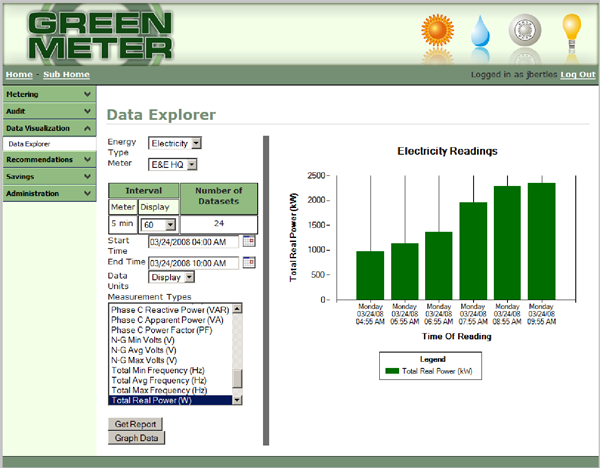
“Business-as-usual” will no longer work if America is to continue its leadership on the world stage. The sweeping effects of the recession we’ve experienced have made this very clear. We need green innovation, state-of-the-art clean energy technologies, and a commitment to change. By pushing these priorities to the forefront we will create a stronger economy, achieve greater energy independence, ensure a healthier environment, and attain a more sustainable future.
“Business-as-usual” will no longer work if America is to continue its leadership on the world stage. The sweeping effects of the recession we’ve experienced have made this very clear. We need green innovation, state-of-the-art clean energy technologies, and a commitment to change. By pushing these priorities to the forefront we will create a stronger economy, achieve greater energy independence, ensure a healthier environment, and attain a more sustainable future.
The 2009 American Recovery and Reinvestment Act (ARRA) offers promise for a more sustainable future. ARRA contains billions of dollars for renewable and cleaner energy, carbon capture and sequestration, and energy demand management through new technologies, energy efficiency, and conservation measures, which are designed to dramatically reduce America’s dependence on fossil fuel and foreign energy and reduce our nation’s 7-billion-ton annual greenhouse gas (GHG) footprint (see my previous column here ). With such a far-reaching and massively funded initiative, it seems likely that we should see impressive results before the end of the current administration’s term.
From an energy demand perspective, one third of our nation’s carbon footprint is attributable to transportation and nearly 60% of these emissions result from gasoline consumption for personal vehicle use, according to the EPA. Tackling transportation-related fuel consumption and GHG emissions requires three key measures: more carbon-efficient vehicles that get more miles to the gallon; vehicles that use less carbon-intense, alternative fuels; and travel demand management measures that reduce the number of vehicle miles traveled.
Of these measures, travel demand management provides an immediate, low-cost approach that maximizes the efficiency of our existing transportation infrastructure by reducing single-occupant vehicle travel (and therefore vehicle miles traveled) through carpooling, vanpooling, mass transit, and other more sustainable travel modes. GIS plays an important role in this aspect because location is a significant factor in influencing the choice of transportation alternatives to driving alone.
For example, GreenRide, a web- and GIS-based solution that enables commuters to instantly identify rideshare alternatives that match their personal preferences, analyzes geographic locations of start, end, and pick-up points, as well as other variables such as schedule, gender, smoking, driving, etc. GreenRide also reinforces the value of ridesharing by personalizing the resulting savings (cost savings relating to fuel and vehicle wear and tear, energy savings from reducing fuel consumption, environmental savings from avoiding GHG emissions, and health benefits from burning calories when commuting by bicycle/walking, etc).
 |
| Web- and GIS-based rideshare solutions like GreenRide® (www.greenride.com) help people to identify ridesharing options that match their personal preferences and quantify their savings. |
The impact of ridesharing programs can be substantial when executed effectively. For example: Ecology and Environment, Inc. —a 1,000-person company—enabled its employees to take over 32 million vehicle miles taken off the road, saving 1.7 million gallons from being consumed, and avoiding many thousands of tons of GHG vehicle emissions since initiating its internal ridesharing program in 1973.
Another example—at the municipal level—is the accomplishment of the City of Redmond, Washington. With a population of 60,000 people, Redmond has taken 20 million miles off the road, saved over 800,000 gallons of gasoline, reduced 684,000 trips, and prevented over 9,000 tons of GHG from entering the atmosphere in just over one year through their commute trip reduction program “R-Trip”. Extrapolated to a statewide or national scale, it is obvious that rideshare programs can make a significant difference, especially when combined with financial and personal recognition—extremely powerful motivators of behavioral change—for both organizations and individuals using the service.
On the facility side, 40% of America’s carbon footprint is attributable to commercial and residential buildings, with over 70% of CO2 emissions resulting from electricity consumption for lighting, cooling, and operating appliances. Energy demand management through simple, low-cost equipment retrofits and behavioral change can provide a quick, economic solution to achieve a marked decrease in energy consumption (and emissions). These measures can include low-cost equipment retrofits; energy management solutions such as GreenMeter; procedural, policy, and/or system changes; outreach and awareness building programs; financial incentives; and individual and organizational recognition.
Examples of low-hanging fruit include optimizing building automation systems, managing thermostat settings; changing out incandescent lighting and implementing controls; changing purchasing policies; installing dual/low-flush toilets; replacing or upgrading equipment such as heating ventilation and air conditioning (HVAC) units; using more energy-efficient computers, faxes, scanners, and phones; integrating recycled office materials (e.g., paper, carpeting, decorative); installing solar panels or micro-turbines to generate electricity; implementing solid waste reduction programs; meeting virtualization; and embracing energy management policies to balance load, compress peak load, and reduce overall consumption.
 |
| Web-based solutions like GreenMeter enable organizations to inventory, track, analyze, and identify opportunities to reduce energy consumption, peak load, and costs. |
For example, Ecology and Environment, Inc.’s Green Office Initiative was launched in 1999 to focus on reducing our environmental footprint; specifically, as it relates to our transportation and buildings. Even though our headquarters building was built to be energy efficient by design in 1987 (it was recently recognized by the U.S. Green Building Council as the oldest existing building to be LEED® Platinum certified), we have still managed to reduce our electricity, natural gas, and water consumption by over 20% compared to our baseline year of 1999. We achieved this through implementing low-cost retrofits and an employee outreach and awareness program to achieve behavioral change (see http://www.ene.com/files/reports/sustainability_2007.pdf for more information).

So what does all of this mean? Quite simply, our country has embarked on a new policy that links economic growth to energy transformation. The ARRA and other initiatives by President Obama are creating new and significant opportunities for positive change. Your organization has the ability to leverage these opportunities to help reduce costs associated with your transportation and building management programs. You have many incentives available to help spark that green innovation. Ultimately, you will not only be working toward reducing your carbon footprint, but you will also give your stakeholders, employees, and surrounding communities something to feel good about as we progress toward a more sustainable future.